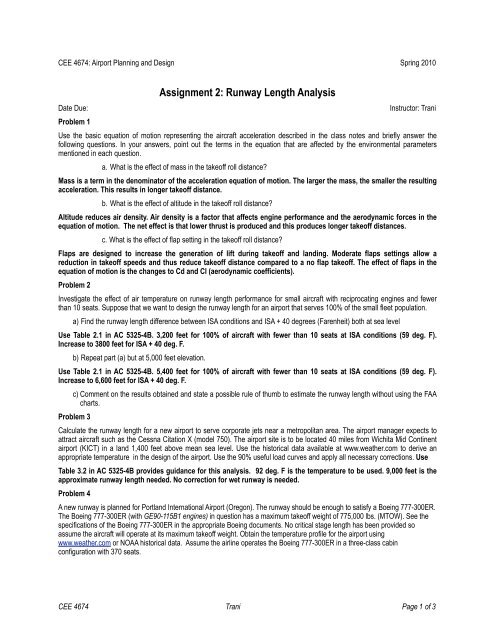Create successful ePaper yourself
Turn your PDF publications into a flip-book with our unique Google optimized e-Paper software.
CEE 4674: Airport Planning and Design Spring 2010<br />
Date Due:<br />
Problem 1<br />
<strong>Assignment</strong> 2: <strong>Runway</strong> <strong>Length</strong> <strong>Analysis</strong><br />
Instructor: Trani<br />
Use the basic equation of motion representing the aircraft acceleration described in the class notes and briefly answer the<br />
following questions. In your answers, point out the terms in the equation that are affected by the environmental parameters<br />
mentioned in each question.<br />
a. What is the effect of mass in the takeoff roll distance?<br />
Mass is a term in the denominator of the acceleration equation of motion. The larger the mass, the smaller the resulting<br />
acceleration. This results in longer takeoff distance.<br />
b. What is the effect of altitude in the takeoff roll distance?<br />
Altitude reduces air density. Air density is a factor that affects engine performance and the aerodynamic forces in the<br />
equation of motion. The net effect is that lower thrust is produced and this produces longer takeoff distances.<br />
c. What is the effect of flap setting in the takeoff roll distance?<br />
Flaps are designed to increase the generation of lift during takeoff and landing. Moderate flaps settings allow a<br />
reduction in takeoff speeds and thus reduce takeoff distance compared to a no flap takeoff. The effect of flaps in the<br />
equation of motion is the changes to Cd and Cl (aerodynamic coefficients).<br />
Problem 2<br />
Investigate the effect of air temperature on runway length performance for small aircraft with reciprocating engines and fewer<br />
than 10 seats. Suppose that we want to design the runway length for an airport that serves 100% of the small fleet population.<br />
a) Find the runway length difference between ISA conditions and ISA + 40 degrees (Farenheit) both at sea level<br />
Use Table 2.1 in AC 5325-4B. 3,200 feet for 100% of aircraft with fewer than 10 seats at ISA conditions (59 deg. F).<br />
Increase to 3800 feet for ISA + 40 deg. F.<br />
b) Repeat part (a) but at 5,000 feet elevation.<br />
Use Table 2.1 in AC 5325-4B. 5,400 feet for 100% of aircraft with fewer than 10 seats at ISA conditions (59 deg. F).<br />
Increase to 6,600 feet for ISA + 40 deg. F.<br />
c) Comment on the results obtained and state a possible rule of thumb to estimate the runway length without using the FAA<br />
charts.<br />
Problem 3<br />
Calculate the runway length for a new airport to serve corporate jets near a metropolitan area. The airport manager expects to<br />
attract aircraft such as the Cessna Citation X (model 750). The airport site is to be located 40 miles from Wichita Mid Continent<br />
airport (KICT) in a land 1,400 feet above mean sea level. Use the historical data available at www.weather.com to derive an<br />
appropriate temperature in the design of the airport. Use the 90% useful load curves and apply all necessary corrections. Use<br />
Table 3.2 in AC 5325-4B provides guidance for this analysis. 92 deg. F is the temperature to be used. 9,000 feet is the<br />
approximate runway length needed. No correction for wet runway is needed.<br />
Problem 4<br />
A new runway is planned for Portland International Airport (Oregon). The runway should be enough to satisfy a Boeing 777-300ER.<br />
The Boeing 777-300ER (with GE90-115B1 engines) in question has a maximum takeoff weight of 775,000 lbs. (MTOW). See the<br />
specifications of the Boeing 777-300ER in the appropriate Boeing documents. No critical stage length has been provided so<br />
assume the aircraft will operate at its maximum takeoff weight. Obtain the temperature profile for the airport using<br />
www.weather.com or NOAA historical data. Assume the airline operates the Boeing 777-300ER in a three-class cabin<br />
configuration with 370 seats.<br />
CEE 4674 Trani Page 1 of 3
a) Find the runway length needed to operate this aircraft at MTOW conditions out of Portland. Clearly state all your<br />
assumptions regarding temperature, field elevation and others. Comment and compare your solution to the existing<br />
runways at PDX. In your calculations assume no grade correction.<br />
b)<br />
Consult the Boeing 777 documents on the web. Use STD dat + 27 deg. F for the analysis. Check the correct figure for<br />
the aircraft with GE90-115B engines. <strong>Runway</strong> length is 10,400 feet. Correct for gradient (20 feet difference) we get 10,600<br />
feet.<br />
c) If one day runway 10L/28R is used for all departures due to a closure of runway 10R/28L for maintenance estimate the<br />
maximum range the aircraft could travel with a full complement of passengers (no cargo).<br />
<strong>Runway</strong> 10L/28R is 8,000 feet. The aircraft could takeoff at a DTW of 680,000 lb (see Figure 2). Work backwards to get an<br />
approximate range (from Payload Range diagram) of 5,700 miles.<br />
Figure 1. Boeing 777-300ER Specifications. Source: Boeing.<br />
CEE 4674 Trani Page 2 of 3
Figure 2. Takeoff Performance for Boeing 777-300ER. Source: Boeing.<br />
CEE 4674 Trani Page 3 of 3

















